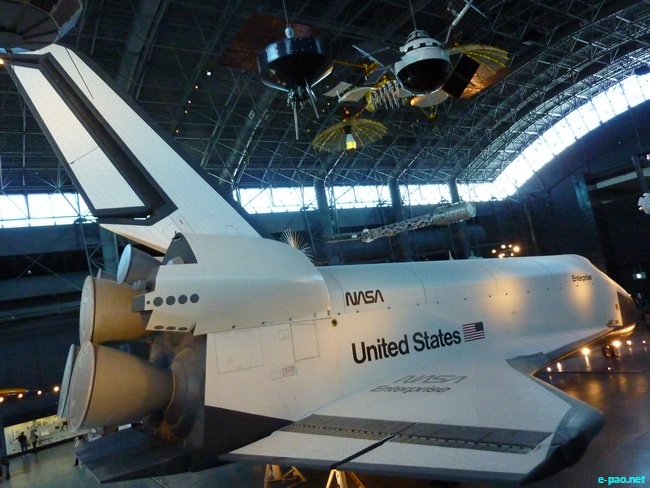Yesterday (Aug 14)
my sister-in-law and her husband took my wife and me to the National
Air and Space Museum Annex near Dulles Airport outside Washington DC,
which I'd never seen. It has some ordinary displays of stuff that is
“lower priority” than the things at the main museum on the Mall,
but also some very large exhibits that literally wouldn't fit. The
annex was huge, and we only saw about 3/4 of it in the 5 or so hours
we were there. The three big deals for me, in roughly this order,
were the Discovery
space shuttle, the SR-71
Blackbird, and the Enola Gay.
It was neat to be
able to see the Shuttle up reasonably close, but of course it is
surrounded by guardrails that keep people from touching it. If I
recall correctly one of the signs said that NASA kept the main
engine, and two of the three auxiliary engines were replicas, but one
of them flew 15 missions. The payload bay was closed; the way the
shuttle was placed you might not have been able to see in even from
the balcony. I was a little disappointed you couldn't go inside, as
you could in the Skylab backup at the Mall museum, but that never
flew in space; Discovery is a national treasure. The CanadArm was on
display beside it.
I don't know how
long the SR71 was there but it was front-and-centre as you came in,
so it may once have been considered a key attraction until Discovery
upstaged it. It was a spy plan that flew at 80,000 feet at Mach 3.2,
back before there were spy satellites. The guided tours started
there. We decided to wander on our own instead of taking the tour,
but one was starting when we got in, so we listened to the docent
talk about it. He kept saying "we did this" and "we
did that". The first time I just assumed he meant the US, but it
turned out he was an actual SR71 pilot.
He talked about some
of the missions they ran. The SR71 produced a double sonic
shockwave, one from the nose and one from each engine nacelle (any
given spot would only be hit by 2 of the 3 sonic booms). Nothing
else made that double-boom sound. It was mostly for spy missions, but
every so often they'd fly over a prisoner of war camp in North
Vietnam (he mentioned the Hanoi
Hilton) to say "we haven't forgotten you." Years later
he got to talk to some of the POWs and they said it helped keep them
going.
Enola
Gay took me by surprise; I recognized it from a distance as a
World War II bomber, and did guess it was a B29 Superfortress, but
didn't realize which one until I saw the name painted on the nose.
So close to Aug 6 it had a lot of emotional impact (this year being
the 70th anniversary of the Hiroshima
atomic bomb).
They're restoring
John
Glenn's Mercury capsule (first US orbital flight). You can see it
from a balcony above the restoration room, which has a half-dozen
things being restored right now, including the Gemini 4 capsule used
for the US' first
spacewalk.
There were a lot of
other interesting planes. One was the "bird
leader" ultralight plane they used in Fly
Away Home. It had a cage around the propeller to minimize the
possibility of damage to the birds. I think it was once a real
working bird-guide plane. I need to read more about it; I thought the
movie made up the concept of leading birds on migrations. They also
have the Gossamer
Albatross, first human-powered plane to cross the English
Channel. Plus a Concorde.
They had a Cessna
150 (a small 2-seater, which I learned to fly on back in 1977),
which kids could get in to play with the controls. Also a simulator
of some sort; if we had more time I would probably have waited in
line to try it out.
I have a little
trouble with one hip, but providentially it didn't start to hurt
until we were ready to leave. I bought two t-shirts in the museum
store and we headed out to brave the rush-hour traffic. All in all, a
very fun day.

No comments:
Post a Comment